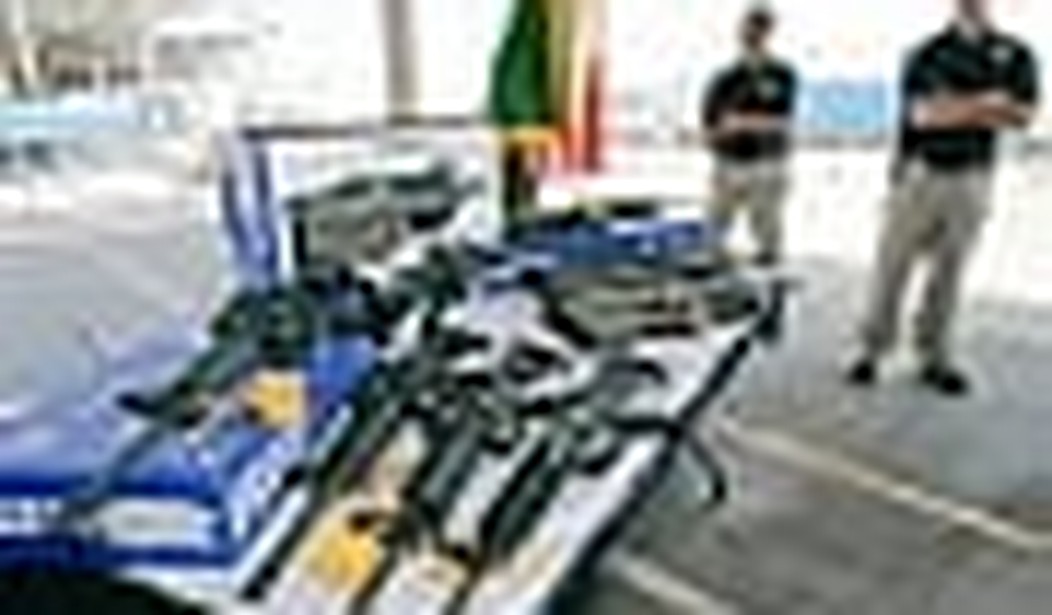It turns out that America’s gun lovers are not completely paranoid. Second Amendment advocates have been taking aim these last weeks at media reports stating that guns smuggled from the U.S. are being used to arm Mexico’s drug cartel gangsters. These gun advocates have tried to discredit the conventional wisdom that the cartels are using these firearms to murder thousands of our southern neighbors. In attacking at this choke point, the gun advocates hope to erode the political footing of those who would like President Obama and the Democrats to enact gun control legislation. Sure enough, just as gun lovers feared, the Brady Campaign to Prevent Gun Violence and several other groups are now exploiting Mexico’s gun smuggling problem in an effort to push for an assault rifle ban.
But these Second Amendment advocates are firing at a phantom target. Their attacks consist mainly of a frontal assault on the only available government statistics that can point to where Mexico’s guns originate: the U.S. Bureau of Alcohol Tobacco, Firearms and Explosives (ATF) traces of serial numbers on weapons captured from the cartels. According to ATF data, at least 90 percent of the guns submitted for tracing originated from American retailers. This number amounts to about 23,843 guns between 2005 and 2008. That’s a fraction of the total Mexico claims to have seized in the same time period. (The Mexicans have provided conflicting totals).
Here, Second Amendment advocates take a mighty leap. They assert that the only possible conclusion is that the untraced guns are coming from another country. And as proof, they point to some of the seized military weapons that can’t be bought in the U.S. Their thinking is as follows: Conspiratorial gun banners and their political and media bedfellows (myself evidently included), keep parroting the inflammatory “90 percent” propaganda because it serves a liberal political crusade to impose restrictions on gun and ammo sales. If policymakers can be made to believe all those untraced guns in Mexico are military weapons from another country, the argument for banning guns is reduced to a shoulder shrug.
However, a cavalcade of consistent anecdotal evidence such as the continuing weapons interdictions at the border, federal prosecutions, and testimony from agents with decades of experience and people involved in the trade, weighs heavily in favor of the official U.S./Mexican government hypothesis that many of the rest of the untraced weapons in Mexico’s vaults also come from U.S. guns stores. One of those agents is J. Dewey Webb, the ranking agent in charge of the Houston ATF field office, which covers much of the Texas border. I asked Webb where he thought the untraced guns were coming from. Without hesitation, he answered: “The United States. I tell you why I say that; I’ve been doing this for 33 years.” Webb said that in 1991 he produced a study detailing where Mexico’s seized guns originate, using access to Mexican archives of gun seizures that he personally traced and other previous ATF studies where predecessors did traces dating back to 1971. Almost all the guns came from U.S. sources. “To assume that just because it didn’t trace that it didn’t come from the U.S. is ridiculous,” Webb said. “I’ve been doing this a long time. The U.S. is the number one supplier all the way back to 1968,” the year Mexico banned most private gun ownership.
Webb told another interesting story from his trip earlier this month to Mexico with Department of Homeland Security Secretary Janet Napolitano. At the firearms conference she attended in Cuernavaca, the Mexican military brought in 30 randomly-seized guns to display as show pieces. Webb said his ATF guys very quietly pulled the trace information on the weapons and ran them. They learned that not one of them had previously been submitted for tracing. All of the weapons in the show display turned out to be from several U.S. states. Webb said he’s pretty sure his guys could repeat those findings in any armory in the Mexican inventory.
It’s hard not to lend credence to this kind of expertise, particularly when any amateur examination of news photos of seized guns always shows only a couple of military grade weapons, with a huge majority of the guns commonly available over the counter in the U.S. Same thing with after-battle news photos of dead cartel gunmen with their U.S.-available weapons — not anti-aircraft guns — at their sides.
Much has been made about why more of the Mexican capture isn’t traced. Because the Mexican military takes control of all seized weapons, some gun advocates conclude in their blogs that Mexico is only cherry-picking guns they know will be traced to the U.S. so that they can deflect potentially embarrassing blame from their own corrupt military services for arming the cartels with their guns. But this doesn’t sit squarely with what I was told by another ATF agent with Mexico experience who now works the U.S. side of the border. This agent literally guffawed at the suggestion that the Mexican government was competent enough to carry out an organized propaganda operation.
The reality is more in line with the military’s spotty competence, he said. The Mexican military refuses to let the ATF do the tracings and instead insists on doing them itself, using an eTrace system provided by the agency. A Mexican intelligence service then forwards the results to the ATF, so agents can start investigating the stores. But the Mexican soldiers have repeatedly proved themselves incapable of properly completing the task. Why? They are untrained to identify the four or five other pieces of information that are often required for a successful trace. They simply don’t know or don’t care that import stamp numbers, caliber, and manufacturer identifiers are often just as important as a serial number.
Another major problem, the agent noted, is that Mexican military officers tend to like store-bought American weapons just as much as drug cartel gunmen. They’re skimming from the caches, sometimes in large quantities, and either keeping them for personal use or reselling them in Mexico. Obviously these weapons aren’t being traced, either.
We may never learn exactly how many confiscated weapons can be traced back to the U.S., but current records of interdictions of southbound guns and ammo reveal that many more could be added to the 23,848 guns the ATF has already traced back to the U.S. Take, for example, the 540 weapons seized in Reynosa in November 2008, billed as the largest weapons seizure in Mexican history. As I reported last month, 383 guns from this stash were submitted for ATF traces that led back to U.S. retailers in eight states, clearly indicating that plenty of cartel guns are being smuggled from America. In typical fashion, the Mexican military refused to allow the ATF access to the cache and offered the ATF no accounting for the 157 other guns not submitted for tracing.
There’s no doubt that one or two of those 157 guns were military weapons smuggled in over the Guatemala border with hand grenades found in the same stash (plainly visible in the news photos). But most of the stash was traced to the U.S. or was obviously available in any U.S. sporting goods store. Extrapolating what we know about Mexican incompetence on the tracing issue, I’d bet a paycheck that most of the 157 were probably from the U.S.
A week ago, an undercover Immigration and Customs Enforcement (ICE) investigation nabbed two Mexicans in El Paso who’d negotiated a $2 million weapons purchase that included a shopping list for more than 300 Colt AR-15 rifles and 10 Barrett .50 caliber sniper rifles commonly available at gun stores here. They also wanted two military grenade launchers, reflecting once again the small sliver of the total take these kinds of weapons probably represent in cartel arsenals.
Some gun advocates have cast aspersions on reporting about cartel ammunition smuggling from U.S. retailers. They claim a nationwide shortage spurred by fear of gun control was ignorantly attributed to cartel ammo smuggling, which must therefore not be happening at all. This flies in the face of the 500,000 rounds found in Reynosa and the nearly three million that Mexican authorities have seized elsewhere since 2007, as well as federal prosecutions and customs interdiction reports.
There is indeed a domestic ammunition shortage. But a couple of weeks ago, Freddie Farhat of Eagle Pass, Texas, allegedly found 10,400 rounds of .223-caliber rifle ammo and attempted to smuggle them into Mexico, along with 200 magazine clips for the AR-15 semiautomatic assault style rifle (ever popular with cartel gunmen).
Every time I write one of these stories, gun advocates accuse me of parroting government or liberal lies and propoganda even though I’m a proud gun owner. But doubters need not take my word as gospel. The respected, non-partisan Factcheck.org just weighed in with its own analysis of this issue and concluded: “Whether the number is 90 percent, or 36 percent, or something else, there’s no dispute that thousands of guns are being illegally transported into Mexico by way of the United States each year.”









Join the conversation as a VIP Member